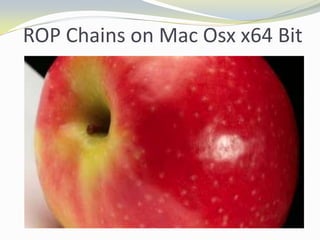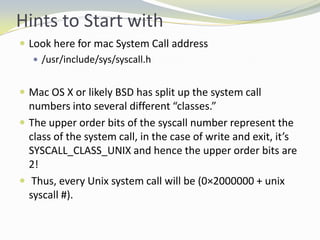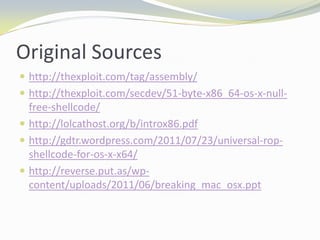Mac osx 64_rop_chains
- 1. ROP Chains on Mac Osx x64 Bit
- 2. Who am I ? ï Rahul Sasi ï Security Researcher @ iSIGHT Partners . ï Member Garage4Hackers.
- 3. Garage 4 Hackers Information Security professionals from Fortune 500, Security research and Consulting firms from all across the world. âĒSecurity Firms âĒConsulting Firms âĒResearch Firms âĒLaw Enforcements http://www.Garage4Hackers.com
- 4. X64 Intro X64 Instruction X64 Debugging Tools X64 Reversing Tools X64 Programing X64 Shell Codes
- 5. Mac / BSD System Arc What's new in mac 10.6 Mac Protection Mechanism Snow Leopard DEP ROP with dyld Examples :
- 7. ï Extension to 32 bit x86 - x64 âlong modeâ ï Can address up to 64 bits (16EB) of virtual memory* ï Can address up to 52 bits (4PB) of physical memory ï 64 bit general purpose registers - RAX, RBX, ... ï 8 new GP registers (R8-R15) ï 8 new 128 bit XMM registers (XMM8-XMM15) New 64 bit instructions: cdqe, lodsq, stosq, etc ï New 64 bit instructions: cdqe, lodsq, stosq, etc ï Ability to reference data relative to instruction pointer (rip)
- 8. Long mode ï 64 bit flat (linear) addressing ï Segment base is always 0 except for FS and GS Stack (SS), Code (CS), Data (DS) always in the same ï segment Default address size is 64 bits ï Default operand size is 32 bits 64 bit operands (RAX, RBX, ...) are specified with âREX prefixâ in the opcode encoding ï 64 bit instruction pointer (RIP) ï 64 bit stack pointer (RSP)
- 9. x64 registers ï 32 bit registers extended to 64 bits ï eax â rax ï ebx â rbx ï esp â rsp ï 8 additional 64 bit registers ï r8, r9, r10, ... r15 ï 8 additional 128 bit XMM (SSE) registers ï xmm8, xmm9, ... xmm15 ï Used for vector and floating point arithmetic
- 10. X64 Registers
- 11. Registers
- 12. X64 Registers
- 13. System V x64 ABI ï Used by Linux, BSD, Mac, others Totally different than MS x64 ABI ï Also totally different than GCC's x86 Linux ABI ï Calling convention uses many registers: ï 6 registers for integer arguments ï 8 registers for float/double arguments ï Some registers considered volatile and can change across function calls, others must be saved by the callee
- 14. Example ï 6 registers for integer parameters ï RDI, RSI, RDX, RCX, R8, R9 ï 8 registers for float/double/vector parameters ï XMM0-XMM7 ï Examples! ï int func1(int a, float b, int c) rax func1(rdi, xmm0, rsi)
- 15. The number of the syscall has to be passed in register rax. ï rdi - used to pass 1st argument to functions ï rsi - used to pass 2nd argument to functions ï rdx - used to pass 3rd argument to functions ï rcx - used to pass 4th argument to functions ï r8 - used to pass 5th argument to functions ï r9 - used to pass 6th argument to functions
- 16. X32 How it did stuffs.
- 17. X64 Bit How stuffs are done.
- 18. How it rolls in x64
- 19. Hints to Start with ï Look here for mac System Call address ï /usr/include/sys/syscall.h ï Mac OS X or likely BSD has split up the system call numbers into several different âclasses.â ï The upper order bits of the syscall number represent the class of the system call, in the case of write and exit, itâs SYSCALL_CLASS_UNIX and hence the upper order bits are 2! ï Thus, every Unix system call will be (0Ã2000000 + unix syscall #).
- 22. Original Sources ï http://thexploit.com/tag/assembly/ ï http://thexploit.com/secdev/51-byte-x86_64-os-x-null- free-shellcode/ ï http://lolcathost.org/b/introx86.pdf ï http://gdtr.wordpress.com/2011/07/23/universal-rop- shellcode-for-os-x-x64/ ï http://reverse.put.as/wp- content/uploads/2011/06/breaking_mac_osx.ppt






















